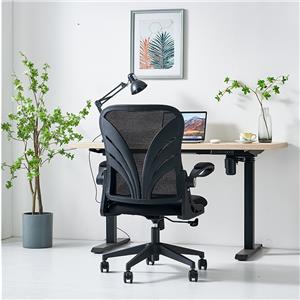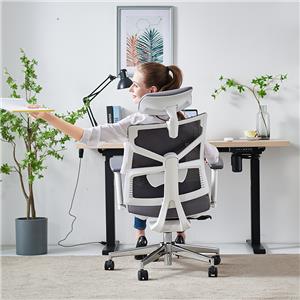Ideal ergonomic environment
First of all, we must understand that people, tables, and chairs are a system. Before buying an ergonomic chair, it is best to check the height of the desktop at home/workplace. Many friends bought ergonomic chairs, but in the end they said they were not suitable. In fact, the desktop If it is too high or too low, what problems will it cause if the desktop is too high or too low?
Desktop height: Take 170cm as an example, for using computers (65-68cm), writing (72-75cm), and repairing mobile phones/watches (above 85cm)
(1) The desktop is too high
If the tabletop is too high, we will adjust the seat too high, so that the feet cannot fully touch the ground and are suspended in the air. The front end of the seat cushion will push against the thighs (impeding blood circulation), which will easily lead to numbness in the legs over time (many people report that the ergonomic chair is not good enough). Suitable, my legs are numb after sitting for a long time, this is one of the reasons).
In addition, if the tabletop is too high, our upper body will be very straight. At this time, we cannot use the back of the chair to provide reasonable support for the waist, back, and shoulders. We can only rely on the waist and abdominal muscles to maintain the sitting posture. Over time, it will be easy to Feeling tired, which can lead to lumbar muscle strain in the long term. Therefore, reasonable back support of ergonomic chairs can alleviate this situation. It is still necessary for people who sit for a long time (whether they are students or office workers) to choose a good ergonomic chair.
If the tabletop is too high and cannot be solved (for example, it is a customized table at home), then you can only put a support under your feet (foot pedals or something).
(2) The desktop is too low
If the tabletop is too low, we will adjust the seat too low, which will increase the weight of the feet, just like you have been standing, and it is easy to cause numbness in the feet over time.
And if you adjust the seat slightly higher, your body will bend forward and assume a chest-holding posture.
You can look at the load-bearing ratio of the human spine in different postures. The forward leaning posture is 1.8 times that of the normal standing posture (30% higher than the 1.5 times of the upright sitting posture).
What happens if the human spine experiences too much pressure?
First of all, you need to know that the human spine is mainly composed of cones and intervertebral discs. The intervertebral disc is divided into three parts: annulus fibrosus, nucleus pulposus, and endplate.
If the pressure on the human spine is too great, it will compress the intervertebral disc. If the intervertebral disc bears too much pressure, long-term compression will cause bulging, protrusion or even prolapse. Leakage of the nucleus pulposus will also cause inflammation, swelling and crushing of the surrounding nerve tissue. Causes low back pain.
If you often feel back pain due to sitting for a long time, you need to pay special attention (see if you often lean forward, is it a habit problem, or is it caused by a mismatched seat)!
In addition to the lumbar intervertebral discs, keeping your head down for a long time will also easily fatigue the neck muscles (which can cause related muscle strain in the long term)!
(3) Reasonable ergonomic environment
A reasonable ergonomic environment should have a reasonable combination of tables and chairs. When the height of the tabletop is appropriate, the seats should be adjusted to the appropriate height:
The feet can touch the ground naturally, and the weight of the calves is borne by the ground instead of hanging in the air (no additional pedals are required).
It should be noted that the height of the desk for working/study and using the computer are different (if you need to switch between these two, it is more appropriate to choose an electric lift table)!
When choosing a seat, appropriate height is the first factor that must be met, so be sure to pay attention to this!
As mentioned above, there are problems with improper matching of tables and chairs. The main reason is that the table top is too high or too low.
Let’s talk about some of the problems existing in some ergonomic chairs currently on the market (mainly because their compatibility with body shapes is not that good)
Problems with body shape mismatch
Since domestic ergonomic chairs are mainly imported from abroad and were mainly sold overseas in the early days, the needs of overseas people will be considered more in the initial design. The size of the entire chair is designed to be wider (usually the seat height is around 48-56cm). In addition, many foreign ergonomic chairs are basically not equipped with headrests (such as Herman Miller Aeron). These are different from the domestic situation.
At present, the designs of most ergonomic chair manufacturers in China are geared towards versatility, so that people of different heights and weights can use them. They tend to be designed to be wider and have a larger recline force. This type is more suitable for people with a height of 160-185cm and a weight of 60-100kg. It is more difficult to choose if the body is too small or too large. The main reason is that the body shape adaptation range indicated by many merchants is within 150-190cm and 200kg, and these are basically false standards.
The main problems with body shape incompatibility are as follows:
(1) The back of the entire chair is too high, or the headrest is too high
For people with smaller stature, if the chair back is too high and the headrest is too high, it will often lead to the headrest not reaching the cervical vertebrae but pushing against the back of the head. In some cases, it is even more exaggerated. Only people with a height of 170cm or above can the pillow reach the cervical vertebrae. .
(2) The seat cushion height is inappropriate
I have already mentioned at the beginning that there are problems with seat cushions that are too high or too low. Here is a summary:
The seat cushion is too high: the feet cannot fully touch the ground and are suspended in the air. The front end of the seat cushion will push against the thighs (impeding blood circulation), which may cause numbness in the legs over time.
The seat cushion is too low: it will increase the load-bearing force of the feet, which will cause numbness in the feet over time; long-term bending over studying/working can also lead to various problems in the lumbar spine/cervical spine.
Under normal circumstances, the reasonable seat height is: our feet should be able to completely touch the ground, the weight of the calves should be borne by the ground, the weight of the upper body should be evenly distributed, and the blood circulation should be smooth.
(3) The backward strength is inappropriate
The recline strength is related to the chassis of the ergonomic chair, which is divided into adjustable and intelligent types.
The adjustable type means that you can manually adjust the recline strength according to your own situation to suit yourself (but there are still some ergonomic chairs that even if you adjust to the minimum recline strength, it is very difficult for people under 60kg to recline).
The major manufacturers of smart chassis have different names, such as adaptive/self-loading/gravity, etc. This means that it can automatically adjust the recline strength according to the user's weight and does not require manual adjustment, but it is not actually that smart. , almost 99% of smart chassis are very body-conscious. People with a light weight cannot lean back (within 60kg), and people with a heavy weight can lean back too loosely (some even 90kg will be loose when leaning on them).
The reason why the recline strength is inappropriate is related to the elastic stroke of the spring on the chassis. It is difficult for a chair to be compatible with the range of 0-200kg. Most elastic strokes are around 60-110kg. There are also some ergonomic chairs that have different weight requirements. Compatibility varies. It is recommended that people with small or large bodies should pay special attention when purchasing ergonomic chairs!
If the recline strength is not appropriate, then you cannot easily switch back and forth between sitting and reclining positions, and the ergonomic dynamic support design will not be able to function.
Ergonomic dynamic support: Whether you are sitting upright, twisting your body, or leaning back, an ergonomic chair should provide reasonable and effective support to your hips, waist, back, and shoulders.




